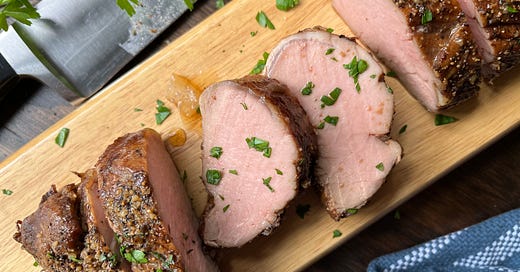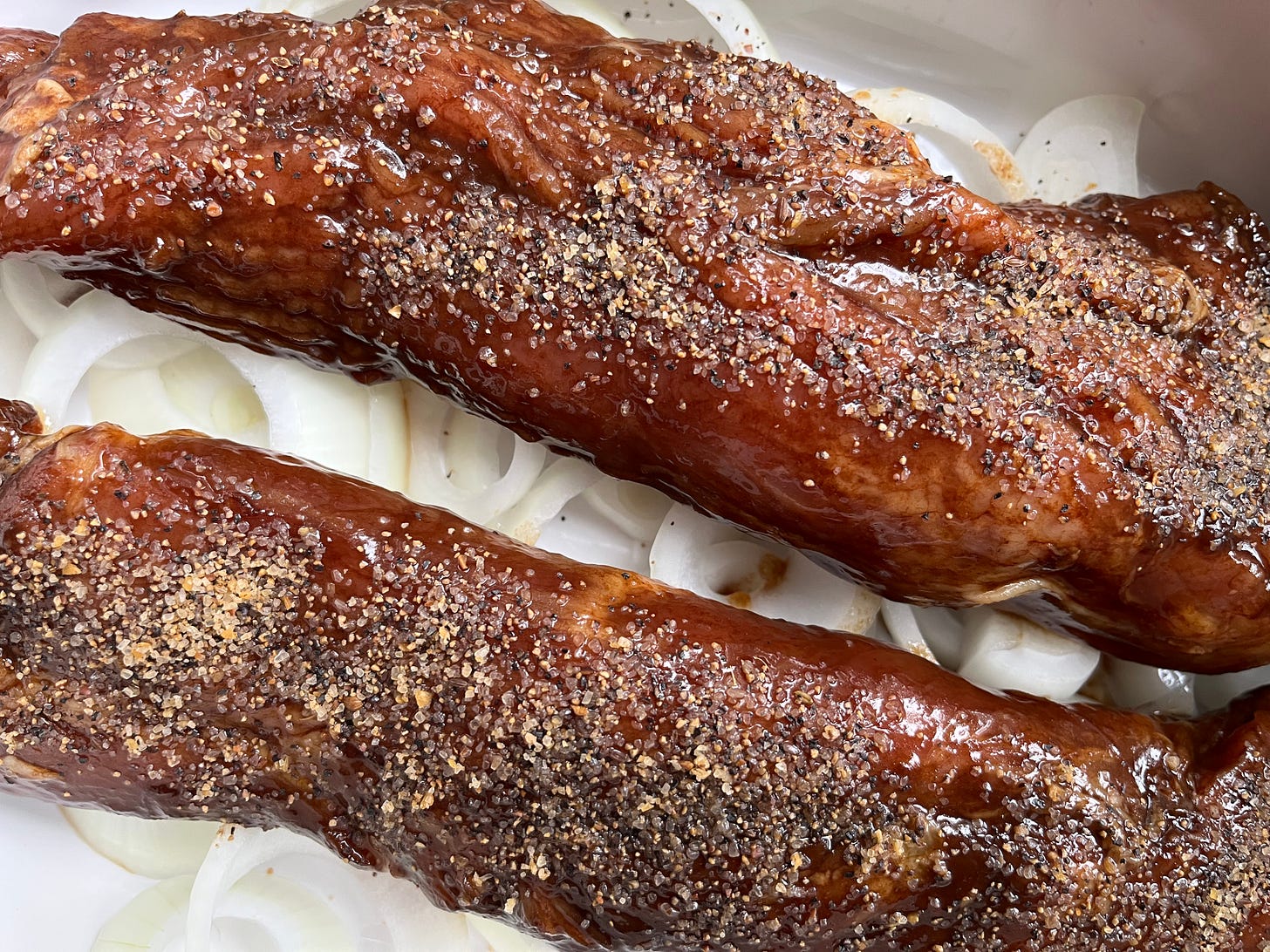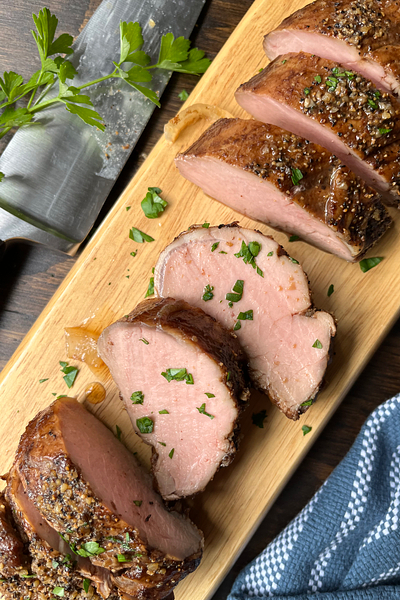Balsamic Marinated Pork Tenderloin
This pork tenderloin is marinated in a mixture of balsamic vinegar, olive oil, and brown sugar. The perfect balance of savory and sweet, this simple, six-ingredient recipe delivers big flavor.
One of the things I love about cooking pork tenderloin is its versatility – it’s perfect for a weeknight family dinner, and elegant enough for entertaining. This cut of pork can be roasted, sautéed, or grilled and its mild flavor lends itself to a variety of seasonings, especially today’s balsamic vinegar and brown sugar marinade.
Pork tenderloin is often confused with pork loin, but in fact, these are two different cuts. Pork tenderloin is a long, narrow, boneless cut of meat with very little visible fat. It typically weighs about a pound and is often sold as two tenderloins per package. Pork loin (also referred to as a pork loin roast) is wide and thick, with a fat cap running along the top. It can be a boneless or bone-in cut of meat and is typically sold in pieces weighing two to four pounds.
Pork tenderloin is an incredibly lean protein choice. In fact, it’s just as lean as boneless, skinless chicken breast. Because it’s so lean, it can easily dry out and become tough if not cooked properly. Let me share three tips for cooking up the juiciest, most tender, pork tenderloin.
The best way to keep pork tender and juicy is to not overcook it. The recommended internal safe temperature for pork tenderloin is 145 degrees. For an accurate reading, place a digital food thermometer in the thickest part of the meat. Once 145 degrees is reached, remove the tenderloin from the oven and allow it to rest for at least five minutes before slicing. This safe cooked temperature leaves the meat juicy with a light pink blush in the center. The resting time is important because it allows the juices to redistribute within the meat. Slicing into the tenderloin straight out of the oven causes the juices to flow out of the meat and onto the cutting board.
Juicy and tender pork cooking tip number two involves marinating the tenderloin. A marinade helps to keep very lean cuts of meat moist and fork tender. For the best flavor, I recommend marinating the tenderloin in the refrigerator for 8 to 24 hours.
One final pork cooking tip comes from my dear friend’s Polish grandmother, or busia as everyone called her. Many years ago, she told me that she likes to cook pork on a bed of thickly sliced onions, as it adds extra flavor and moisture to the meat. Oh boy, was she right. You can discard the onions after the pork is cooked if you prefer, but I like to serve them alongside the tenderloin. They caramelize a bit and become really mellow and sweet – so delicious!
To your health,
Darlene
Follow Recipes Made Healthy on Instagram
BALSAMIC MARINATED PORK TENDERLOIN
Yield: 6 servings
Serving Size: 4 ounces cooked pork tenderloin
Prep: 10 minutes
Ready: 55 minutes (not including marinating time)
INGREDIENTS
1/2 cup balsamic vinegar
1/4 cup olive oil
1/4 cup brown sugar
2 (1 pound each) pork tenderloins
1 large sweet onion (such as Vidalia, Walla Walla, or Maui)
2 teaspoons steak seasoning blend (such as McCormick® Montreal Steak Seasoning)
DIRECTIONS
In a large bowl, whisk together vinegar, oil, and brown sugar. Pour marinade into a zip-top bag, add pork tenderloins and marinate at least 8 hours or overnight.
When ready to cook tenderloins, cut onion into thick slices. Separate slices into rings and place in bottom of a large baking dish. Place marinated pork tenderloins on top of onion rings and discard marinade. Sprinkle top of each tenderloin with 1 teaspoon steak seasoning.
Place, uncovered, in a preheated 350-degree oven. Roast until pork reaches an internal temperature of 145 degrees; about 35 to 45 minutes. Remove from oven and let pork rest at least 5 minutes before slicing.
Nutrition Information per Serving
204 Calories, 6 g Total fat, 1.5 g Saturated fat, 0 g Trans fat, 83 mg Cholesterol, 307 mg Sodium, 5 g Total carbohydrate, 0 g Dietary fiber, 4 g Total sugars, 2 g Added sugars, 30 g Protein, 0 mcg (0%) Vitamin D, 14 mg (2%) Calcium, 1 mg (6%) Iron, 520 mg (10%) Potassium
Adapted from Allrecipes.com and tested by Darlene Zimmerman, MS, RD
© 2023 RECIPES MADE HEALTHY BY DARLENE ZIMMERMAN, MS, RD LLC








Hey Chris, great comment. So many of us were trained to overcook pork. Several years back the safe cooked temperature for whole cuts of pork was revised down to 145 degrees with a resting period. Once I began monitoring the temperature and not letting it go above 145, I really started enjoying pork tenderloin more - it really is moist, juicy, and delicious. Hope you like the recipe 😊.
Darlene,
Thank you so much for this recipe! I have struggled with cooking pork as I tend to dry it out in overcompensating to ensure it is fully cooked. What a beautiful solution in the tasty marinade as well as the bed of onions and cooking temperature. I can't wait to try it!